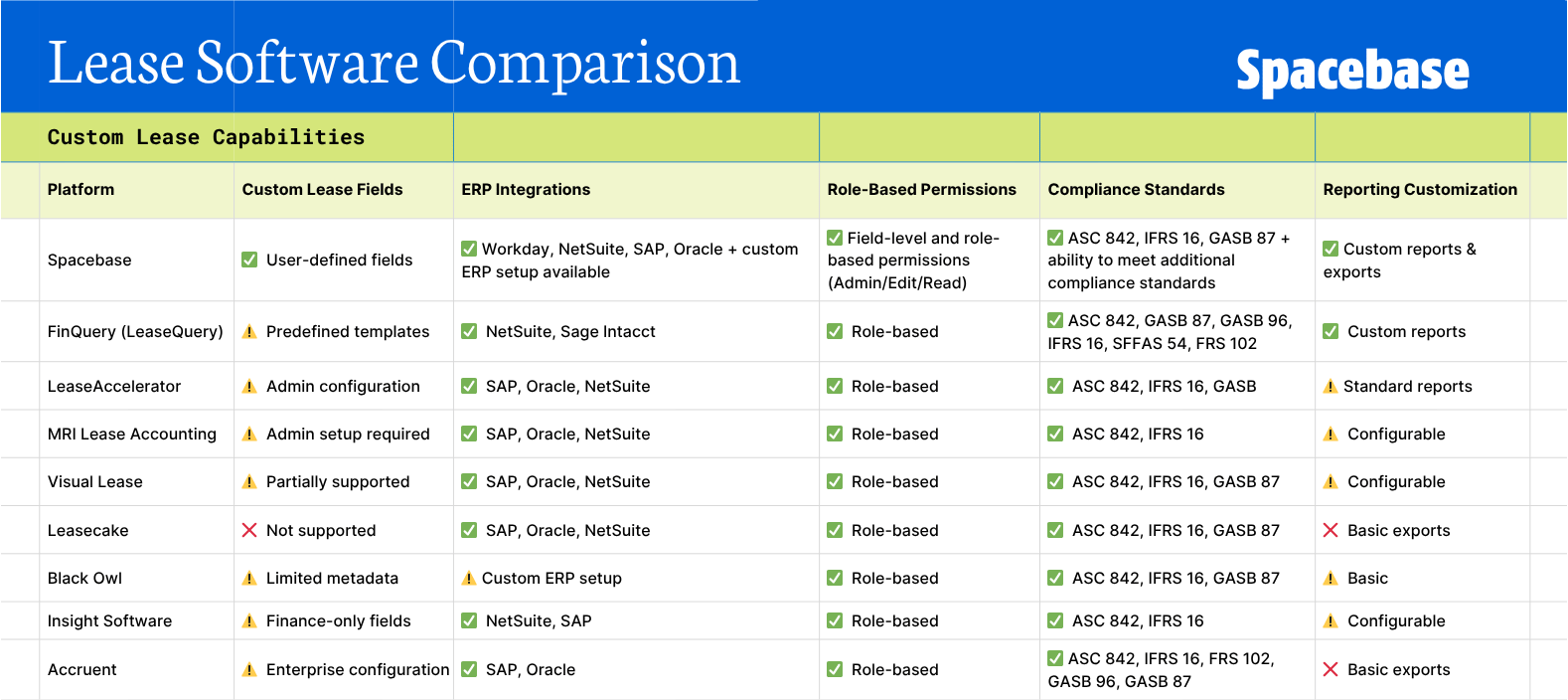Custom Lease Fields: The Missing Flexibility in Most Lease Accounting Software
Summary:
Most lease accounting platforms limit users to predefined templates, leaving finance teams struggling to track data that matters to their business. Spacebase solves this by enabling custom lease fields across both lease administration and accounting, giving teams full control over compliance, reporting, and data integrity.
In a world where every portfolio is unique, standardized lease data isn’t enough. Finance and real estate teams need a way to track what actually matters, whether that’s a GL code, a business segment, or a region-specific insurance clause.
Most lease accounting systems fall short here. They force users into rigid templates, making it hard to align lease data with reporting requirements or ERP structures. Spacebase changes that by offering fully customizable lease fields across both lease administration and lease accounting modules.
What Are Custom Lease Fields?
Custom lease fields are user-defined data points that let companies capture details unique to their operations. Rather than being limited to a standard set of values, teams can define and name their own fields, for example, “PO Number,” “Functional Area,” or “Equipment Type.”
In Spacebase, custom fields appear directly in each lease record and can be configured by administrators with specific access permissions. This flexibility helps teams:
- Maintain consistency across accounting and real estate workflows
- Standardize reporting for ASC 842, IFRS 16, and GASB 87 compliance
- Capture additional data points for regional or entity-level analysis

Screenshot of custom lease fields in Spacebase lease accounting platform.
How Spacebase Enables Full Customization
Spacebase lets administrators create, edit, and organize custom fields for any lease, across both modules.
Here’s what makes the system uniquely flexible:
- User-created fields: Define new fields for business-specific data (e.g., project code, vendor ID, or region).
- Field-level permissions: Limit access by role (Admin, Edit, Read-only) to maintain security and control.
- Cross-module consistency: Custom fields are shared across lease administration and lease accounting, ensuring data accuracy between teams.
- ERP integration: Map fields directly to ERP systems like Workday, NetSuite, SAP, or Oracle to streamline exports and journal entries.
For global portfolios, this structure eliminates the manual reconciliation that comes from maintaining duplicate data in separate systems.
How Spacebase Compares to Other Platforms
While most competitors advertise “custom reporting” or “workflow flexibility,” very few actually allow users to define their own data fields and control access at the field level. Spacebase offers true field-level configurability, letting teams capture the details that matter most from cost centers and PO numbers to insurance amounts and regional identifiers.
The table below compares how major lease accounting platforms handle custom fields, ERP integrations, and compliance capabilities.

Most platforms stop short of full customization. They may let users adjust labels or add notes, but don’t allow new fields to be created and integrated across both lease administration and accounting workflows. Spacebase was built differently, designed to mirror the way organizations actually operate, not force them into rigid templates.
Why Customization Matters for Compliance
Every compliance standard ASC 842, IFRS 16, and GASB 87, requires granular data tracking. But not every company defines those data points the same way.
A multinational organization might track leases by functional area or cost center, while another may segment data by region or subsidiary.
Custom fields let each company align its internal reporting structure with its audit requirements. In Spacebase, this means every field, whether standard or user-created, can be included in reports, journal entries, and disclosure templates.
This design ensures that audit-ready data lives in a single system of record, not in disconnected spreadsheets.
Why Most Platforms Fall Short
Many lease systems treat “customization” as a cosmetic feature rather than a structural one.
They may let users change column labels or hide fields, but they don’t support creating new data points that flow through accounting and reporting logic.
Without flexibility, finance teams often resort to storing supplemental details in separate systems, increasing risk and breaking compliance consistency.
Spacebase eliminates that limitation by giving teams complete control over the data model, without compromising security, compliance, or ERP alignment.
The Advantage of Configurable Lease Data
At its core, customization in Spacebase isn’t about aesthetics; it’s about control.
By tailoring lease data structures to the realities of each organization, finance teams gain the visibility and compliance precision they need to scale.
To see how configurable lease fields can improve reporting and audit readiness, request a demo or explore our products below:
For more on compliance and visibility:
- Breaking Down the Lease Amortization Schedule →
- Managing Multiple Accounting Standards in Spacebase →
Disclaimer
Feature and compliance information for the listed software vendors was gathered from publicly available sources as of October 2025, including product pages and documentation. This comparison is provided for informational purposes only and may not reflect the most current product capabilities. Spacebase makes no representations or warranties regarding the accuracy or completeness of this third-party information.
Footnotes
- FinQuery Feature Overview
- LeaseAccelerator Product Capabilities
- MRI Lease Accounting Overview
- Visual Lease Platform Overview
- Leasecake Product Page
- Black Owl Features
- Insight Software Solutions Overview
- Accruent Lease Accounting Software

Brooke Colglazier
Marketing Manager